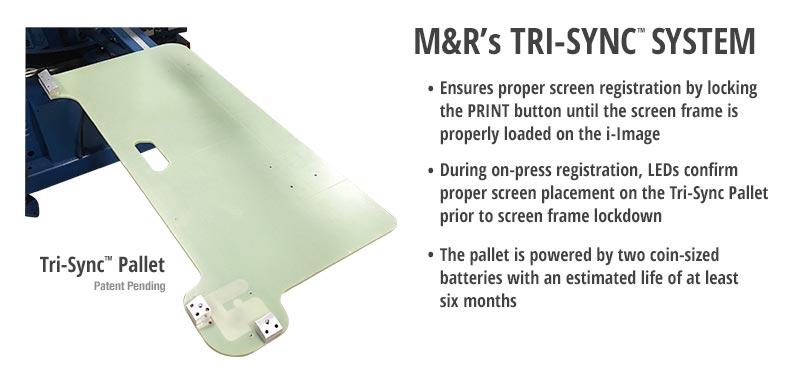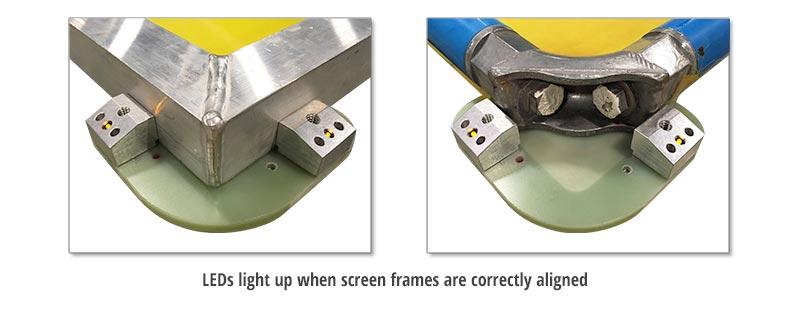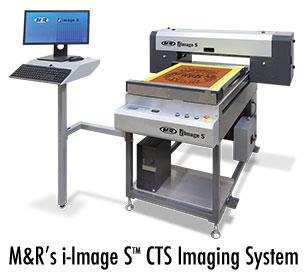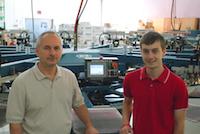Computer-to-screen (CTS) systems have been available to screen printing shops for nearly a quarter century. As with most new technologies, early versions were expensive, prone to problems, and lacking in features. Only in recent years has CTS become a mature technology.
As the technology became more popular and competition among manufacturers increased, prices stabilized or declined, while features and performance steadily grew. At the same time, labor costs, especially that of skilled labor, continued to increase. The combination of reduced prices, improved performance, and increasing labor costs makes CTS technology a consideration for all but the smallest shops.
Here are a few of the benefits of CTS technology to be found in systems like M&R's i-Image S™ and i-ImageST™ imaging systems and M&R's i-Image STE I™ imaging and exposure system:
- The shop's graphic artists no longer need to wait for film printing and stripping, leaving them more time to concentrate on artwork
- Computerized RIP software helps ease workflow. The ability to integrate artwork RIP into the operation's server or workgroup eases file transfers and post-print organization, and it makes storage and retrieval far simpler than filing films and storing imaged screens
- Direct printing on screen emulsion eliminates the need for a conventional exposure system with its vacuum and glass. That does away with pinholes, and it cuts screen burn time in half because there's no waiting for vacuum drawdown and no glass to refract light. The CTS process also eliminates undercutting because there is no way for light to reflect around the dot and narrow the gap of the image
- During washout, the person cleaning the screen can see exactly what needs to be washed to ensure all details are accounted for
Typically, the screen-creation process will take 25 minutes per screen to complete. That's far longer than the seven minutes it takes with some of the most integrated CTS units on the market.
Here's a checklist comparing the steps required for film to those required for CTS:
| PROCESS | FILM | CTS |
|---|---|---|
| RIP | X | X |
| Film output | X | |
| Cutting | X | |
| Moving to screen room | X | |
| Coating & drying screen | X | X |
| Stripping up film | X | |
| Placing on vacuum frame | X | |
| Drawdown | X | |
| Long exposure | X | |
| Image & expose screen | X | |
| Washout | X | X |
| File films | X |
By eliminating so many steps, the CTS approach to screen imaging and exposure frees up employees to work elsewhere in the facility.
However, step reduction is only one of the benefits. Some companies manufacture CTS systems and companion screen registrations systems. When using both systems, operators can generate screens that are automatically preregistered for installation on the press. Aligning screens without a preregistration system is a time-consuming process of visual screen alignment followed by test prints, followed by more screen adjustments and more tests. And the number of adjustments and test prints is directly related to the skill of the person doing screen setup. That often means the skill is limited to just a few employees. When they're not available, the screen setup process can slow down significantly—and the resultant prints can suffer from quality defects. But even the best setup person can't align screens visually as quickly as someone can do it using a screen registration system, so it only makes sense to adopt a CTS/preregistration system—like the i-Image S or i-Image STE I and M&R's Tri-Loc® Rapid Registration System—that virtually every employee can employ successfully. And to make preregistration even easier, M&R developed the Tri-Sync System (U.S. Patent Pending). When an operator correctly loads a screen frame into any i-Image CTS system, LEDs light up and the imaging process is allowed to continue. Similarly, M&R's Tri-Sync™ pallet lets operators know when preregistered screens are properly loaded on the press. It's just one more way M&R helps users get the most out of their equipment.


On the shop floor, the CTS-generated preregistered screen will put the entire press setup team on the same high level instead of relying on one or two highly-trained employees. With everyone following the same processes using the same tools, press setup times and the time needed to train new employees will dramatically decrease. In addition, CTS units can be integrated with equipment like coating machines and rinsing machines to create a highly- integrated, extremely efficient prepress screen preparation operation that produces superior output with fewer employees. In fact, by combining M&R's i-Image STE I™ imaging and exposure system with the Uni-Kote™ automatic screen coater and the Eco-Rinse™ rinsing system, a single operator can coat, image, expose, and rinse up to 400 screens in a single eight-hour shift. Watch the video below.




